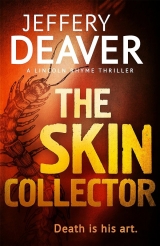
Текст книги "The Skin Collector"
Автор книги: Jeffery Deaver
Жанр:
Триллеры
сообщить о нарушении
Текущая страница: 10 (всего у книги 28 страниц)
CHAPTER 24
Rhyme was wheeling back and forth, back and forth, in front of the high definition monitor. It was around forty minutes after the report had come in about the perp releasing the poison gas in the sixth floor suite in the doctors’ office building.
On the screen was an image of the front of the building and, beyond that, the hospital itself.
Courtesy of an Emergency Service Unit video cam.
The buzzer sounded and Thom went to answer. The door clicked, the wind howled.
Then a familiar clomp of footsteps, which told Rhyme that Lon Sellitto had arrived.
Ah …
The detective turned the corner. Stopped. His face was a grimace.
‘Now,’ Rhyme said, his voice infused with sharp humor. ‘I’m just curious–’
‘All right, Linc,’ Sellitto said, stripping off the wet Burberry. ‘It was–’
‘Curious, I was saying. Did it occur to anyone ? Any single one? Did it occur to any person on the face of the earth that it wasn’t an orderly reporting the poison gas? That it was the unsub himself who called in a fake report? So that everyone would start checking out patients with bandages on their faces?’
‘Linc–’
‘And no one would start checking out anyone in a dental face guard, like tattoo artists would wear, and coveralls, strolling casually out the front door like an emergency worker.’
‘I know that now, Linc.’
‘So I guess it didn’t occur to anyone at the time. It’s only–’
‘You made your fucking point.’
‘–now that we can figure out–’
‘You can be a real prick sometimes, Linc. You know that.’
Rhyme did know that and he didn’t care. ‘And the manhunt around Marble Hill?’
‘Checkpoints at main streets, officers at every bus stop and subway station in the area.’
‘Looking for …?’ Rhyme asked.
‘Any white male around thirty with a pulse.’
Rhyme’s computer dinged, and he called up the email. It was Jean Eagleston again, the Crime Scene officer. She was the one who’d done an Identi Kit composite rendering of the man, based on Harriet Stanton’s observation. It depicted an unsmiling young man with Slavic features, a prominent forehead and brows close together. The unsub’s pale eyes gave him a startling, eerie visage.
Rhyme didn’t believe that good or evil could be objectively reflected in appearance. But his gut told him this was the face of a truly dangerous person.
A second high def monitor nearby fluttered to life and there was Amelia Sachs, peering his way.
‘You there, Rhyme?’
‘Yes, yes, Sachs. Go ahead.’ This was the computer they used for face to face videoconferencing with law enforcers in other cities, for occasional interrogation of suspects and for Skyping with the children of Rhyme’s closest relative – his cousin who lived in New Jersey – well, Sachs primarily, who read them stories and told jokes. Sachs and Pam would also Skype, sometimes spending hours, chatting away.
He wondered if now, after their fight, that wouldn’t be happening anymore.
She asked, ‘What’s the story? Is it true, the getaway?’
Rhyme grimaced and glanced at Sellitto, who rolled his eyes and said, ‘He’s gone, yeah. But we got a good description from the hostage.’
‘What’s the prognosis, Sachs? The guard?’
‘Eyes’re going to need some treatment is all. He got hit by formaldehyde and severed male genitals. That’s what was in the jar. Which he’s not happy about.’ She gave a faint laugh. ‘It was dark, I saw some flesh on the ground. I thought the unsub had used acid and it was melting the guard’s flesh off. But he’ll be okay. Now, Lon, how’s the manhunt going?’
The detective explained to her, ‘We’ve got undercover at all the bus and subway stations in Marble Hill and north and south – the Number One train. He could get a cab but I’m thinking he won’t want to be seen one on one – by the driver. According to our tat expert, he’s not from around here so he probably doesn’t know about gypsy cabs. We’re betting he’ll stick to public transportation.’
Rhyme could see Sachs nodding, then the image was breaking up, freezing. The unreliable Internet.
The picture came in clear again.
She said, ‘He might try for a train farther east.’
‘Yeah, I suppose he could.’
Rhyme said, ‘Good point.’ He told Sellitto, ‘Get some of your people to the Number Four train and the D and B lines. That’s central Bronx. He’s not going to get farther east than that.’
‘Hm. I’ll do it.’ The detective stepped away to make the call.
Sachs said, ‘One thing occurred to me, Rhyme?’
‘And?’
‘There were dozens of storerooms he could’ve hidden in. Why did he pick that one?’
‘Your thought?’
‘He’d spent time there before. I think that’s where he was going to take Harriet Stanton to tattoo her.’
‘Why?’
‘It was like a skin museum.’ She described the preserved tissue samples in jars.
‘Skin. Sure. His obsession.’
‘Exactly. Internal organs, brains. But easily half the jars contained external flesh.’
‘You working up some kind of dark psychology here, Sachs? I’m not sure that’s helpful. We know he’s interested in skin.’
‘I’m just figuring he’d spent more time there than just checking it out as a possible murder site. Like a tourist at MoMA, you know. It drew him. So I walked the grid three times there.’
‘Now, that’s a valid use for psychobabble,’ Rhyme said.
CHAPTER 25
Head down, Billy strode quickly toward the subway in the Bronx that would take him south to Manhattan, to his workshop, to his terrariums, to safety and comfort.
He reflected back to the hospital corridor, picturing Amelia Sachs … He couldn’t help but think of her with some familiarity, having learned everything he could about the woman – and Lincoln Rhyme.
How had she found him? Well, that wasn’t quite the question. How had Rhyme found him? She was good, sure. But Rhyme was better.
Okay, how? How exactly ?
Well, he’d been to the hospital earlier. Maybe he’d picked up some trace there and, despite his diligence, had unwittingly deposited a bit near Chloe Moore’s body.
Were the police thinking they’d avert another attack by sending Amelia Sachs to stop him?
But, no, Billy decided, they couldn’t predict that he’d return when he had. The policewoman had come to the hospital just to ask if any staffers had seen a man fitting his description.
His thoughts strayed to Amelia Sachs … She reminded him in some ways of Lovely Girl, her beautiful face, her hair, her keen and determined eyes. Some women, he knew, you had to control by reasoning with them, some by dominating. Others you couldn’t control, and that was a problem.
Picturing her pale skin.
The Oleander Room …
He imagined Amelia there, lying on the couch, the settee, the love seat, the lounger.
Breath growing faster, he pictured blood on her skin, he tasted blood on her skin. He smelled blood.
But forget that now.
Another word came to mind: anticipate.
If Rhyme had figured out about the hospital, he might have figured out Billy would come this way to escape. So he picked up his pace. It was a busy street. Discount shops, diners, and mobile phone and calling card stores. The clientele, working class. Payroll Advances. Best Rates in Town.
And people everywhere: parents with little kids, bundled up like sock puppets against the cutting chill and endless sleet. Teenagers ignoring the cold or genuinely not feeling it. Thin jackets, jeans, short skirts and fake fur collars on loud jackets. High heels, no stockings. Constant motion. Billy dodged a skateboarder a moment before collision.
He wanted to grab the kid, fling him off the board. But he was past in a flash. Besides, Billy wouldn’t have made a scene. Bad idea, under the circumstances.
Back to his eastward escape. He noted here too a lot of skin art – Billy’s preferred term for tats. Here, lower class, mixed race, he noticed a lot of writing on skin. In script primarily. Bible passages maybe or poems or manifestos. Martin Luther King, Jr., was represented, Billy speculated. But the lines might have been from Shaq or the Koran. Some writings were prominent – seventy two point type. Most, though, were so tiny you needed a magnifier to read them.
Crosses in all designs – inked on men who looked like gangbangers and drug dealers and on girls who looked like whores.
A young man, around twenty, approached from the opposite direction, very dark skinned, broad, a bit shorter than Billy, who stared at the keloids on his cheeks and temples – an intricate pattern of crosshatched lines.
He noticed Billy’s attention and slowed, then stopped, nodded. ‘Hey.’ Just stood there, smiling. Maybe he sensed that Billy was appreciating the scarification. Which he was.
Billy stopped too. ‘You’ve got some righteous marking.’
‘Yo. Thanks.’
In sub Saharan African tradition this form of modification was done by cutting flaps in the skin and packing in irritating plant juices to raise welts, which hardened into permanent designs. Keloids serve several purposes: They identify the bearers as members of a particular family or tribe, they indicate fixed social or political positions, they mark milestones in life’s transit, like puberty and readiness for marriage. In some African cultures, scarification indicates sexual prowess and appetite – and the scars themselves can become erogenous zones. The more extensive a woman’s scarring, the more appealing she is as a partner because it implies she’s better able to withstand the pain of childbirth and produce many offspring.
Billy had always appreciated keloids; he’d never done any. The ones on the young man’s face were impressive, linked chains and vines. African skin art is largely geometric; rarely are animals, plants or people depicted. Never words. Billy was nearly overcome by an urge to touch the pattern. With effort, he resisted.
The local, in turn, regarded Billy with an odd gaze that embraced both curiosity and camaraderie. Finally he looked around and seemed to come to a decision. A whisper: ‘Yo, you want brown? Moonrock? Sugar? Whatchu want?’
‘I …’
‘How much you got to spend? I hook you up.’
Drugs.
Disgusting.
In an instant the admiration of the scarification turned to hatred. It felt like the young man had betrayed him. The skin art was ruined. Billy wanted to stick his neck with a needle, get him into an alley and ink a message on his gut with snakeroot or hemlock.
But then Billy realized this was just another incident that proved the Rule of Skin true. No surprise here. He could be no more upset at this than a law of physics.
He gave a disappointed smile, walked around the man and kept moving.
‘Yo, I hook you up!’
A block east, Billy glanced behind him – he saw no one that was a threat – and stepped into a clothing store. He paid cash for a Yankees baseball cap and a pair of cheap sneakers. He tugged the hat on and swapped shoes. His old ones he didn’t throw out – concerned that the police might search the trash cans and find a pair of Bass with his prints on them – but when the clerk wasn’t looking he left one in a bin of discount shoes and the other on a rack, behind a row of similar footwear. He then stepped outside, striding fast toward his goal: the subway that would take him back to Canal Street, back to safety. Head down, once more, examining the congested sidewalks, filthy, marred with ovals of dog pee and dark dots of chewing gum, bordered with tired slush.
Yet no one looked at the coveralls, at the gear bag, no one glanced his way as if wondering: Is he the man who killed that girl in SoHo? The man who was nearly cornered and gunned down at the hospital in Marble Hill?
Walking fast once more, inhaling cold air rich with noxious exhaust. Of course he wouldn’t take the Number One train, which had a Marble Hill stop, because it was so close to the hospital. He’d spent days studying the New York City transit system. He was making for a station farther east, even if it meant a fast walk through unpleasant weather and amid more unpleasant people.
Yo, I hook you up …
And there were lots of them. The crowds were thicker now, more shoppers – taking advantage of the pre Christmas season to stock up on presents, he guessed. Dressed in dark clothing, worn and shabby.
Doctor Moreau’s Swine men, Dog men …
Some police cars sped past, heading toward Marble Hill. None of them paused.
Breathing hard, chest hurting again, he finally approached the metro entrance. Here the trains were not underground but elevated. He swiped his Metrocard and walked nonchalantly up the steep stairs and onto the platform, where he huddled as the damp wind sliced around him.
He pulled his cap lower, swapped the reading glasses for some with different frames, then pulled his gray scarf up around his mouth; the air was frigid enough so that this didn’t look odd.
Scanning for police. No flashing lights on the streets below, no uniformed officers in the crowds or on the platform. Maybe–
But wait.
He noted two men in overcoats about thirty feet away on the platform. One looked his way then turned back to his companion. They stood out here, being white and dressed in conservative clothing, white shirts and ties, under the bulky coats; most of the other passengers on the platform were black or Latino or mixed, and dressed much more casually.
Undercover cops? He had a feeling they were. They might not have been part of the actual manhunt – were here investigating a drug deal, maybe – but they’d heard the alert, and now believed they had the Underground Man.
One made a brief call and Billy had a feeling that it had been placed to Lincoln Rhyme. No basis for this, but instinct told him the cop was a friend and colleague of Rhyme’s.
A train was approaching but was still two hundred yards away. The men whispered something to each other and then walked his way, steadying themselves in the wind.
He’d been so careful, so smart in escaping from the doctors’ office building. Was he about to get caught because of a coincidence? Two cops who happened nearby.
Billy was nowhere near the exit. If he ran, he’d never make it in time. Could he jump?
No, twenty feet to the traffic filled street below. He’d break bones.
Billy decided he’d just have to bluff. He had a city employee ID, which would pass fast examination, but one call to downtown and they’d find out it was fake. He also had legitimate ID, which was, technically, a breach of the Commandments.
Thou shalt remain unidentifiable.
But, of course, that wouldn’t work. One radio or phone call and they’d find out who he really was.
He’d have to go on the offense. He’d pretend to ignore the men until they were right next to him and turn, smiling. Then he would shove one, or both, onto the tracks. He could escape in the chaos afterwards.
A messy plan. Clumsy and dangerous. But, he decided, there was little choice.
The men were getting closer now. Smiling but Billy didn’t trust that expression for a second.
The train was near now. A hundred feet away, eighty, thirty …
He looked for guns on the men’s hips, but they hadn’t unbuttoned their coats. He glanced toward the exit, judged timing and distance.
Get ready. The big one. Push him first. Lincoln Rhyme’s buddy.
The train was almost to the platform.
The taller of the two men, the one who was about to die first, nodded as he caught Billy’s eye.
Wait, wait. Give it ten seconds more. Eight, seven, six …
Billy tensed.
Four, three …
The man then smiled. ‘Eric?’
‘I’m, uhm, I’m sorry?’
‘Are you Eric Wilson?’
The train rushed into the station and squealed to a stop.
‘Me? No.’
‘Oh, hey, you look just like the son of a guy I work with. Sorry to bother you.’
‘No problem.’ Billy’s hands were trembling, his jaw too, and only partly from the cold.
The men turned and walked away, toward the train, which was now discharging passengers.
Billy walked onto the subway car, choosing a spot to stand that was close enough to the men to hear their conversation. Yes, he realized, they were just as they seemed to be – businessmen who’d finished some meeting uptown and were heading back to their office on Madison Avenue to write up some reports about how the meeting had gone.
Brakes released, and with a grind the train started south, rocking, squealing through the switches.
Soon they were in Manhattan, and diving beneath the surface. The Underground Man was in his world once again.
It had been a risk, taking the subway, but at least he’d minimized the danger. And apparently won. Rather than take the Number One train or the Number Four – the next one east – or even the B and D, he’d sped the several miles to the Allerton Avenue station, to catch the Number Two train. He’d assumed that someone – well, Lincoln Rhyme of course – might have ordered officers to the closer stations. But even the NYPD didn’t have the resources to search everywhere. He’d hoped his brisk pace would put him beyond the reach of a manhunt.
Apparently this was so.
As they sped south, Billy reflected: You’re not the only one who can anticipate, Captain Rhyme.
CHAPTER 26
Mr 11 5 knows what he’s doing, Lincoln Rhyme reflected yet again, as he guided his Merits to the evidence examination table, where Mel Cooper and Sachs were examining the evidence from the hospital.
Despite her exhaustive search of the corridors, the doctors’ office building and the ‘skin museum’, the evidentiary findings from the abortive assault on Harriet Stanton were minimal.
There were no friction ridges; he’d been clever enough not to actually touch Harriet with his fingers (prints can be lifted off skin). He’d either gripped only her clothing or touched her flesh with his sleeves. And somewhere between fleeing the site of the attack in the basement and his slipping into the specimens room, he’d pulled on latex gloves (not vinyl, which display distinctive wrinkle patterns that can be introduced at trial).
But unlike the earlier scenes, he’d been taken by surprise, so he didn’t have the chance to don booties. Sachs got some good electrostatic footprints.
Size eleven Bass shoe, though that meant only that he was wearing a size eleven Bass shoe, not that he had size eleven feet.
The wear pattern of the tread marks, which sometimes could give details about weight and posture, didn’t reveal much but, Rhyme reflected, who cared? They knew his weight and posture.
Sachs rolled the floor around the footprints for trace, just in case. But Mel Cooper reported that the analysis revealed, ‘A lot of Inwood marble and more of the cleanser and medical materials that had led us to the hospital in the first place. Some of the cleanser again. Nothing else.’
She had found some unique trace in the specimens room, identified by the chromatograph/spectrometer as dimethicone, which was used in cosmetics and industrial lubricants and processed foods to prevent caking. Interestingly it was also the primary ingredient in Silly Putty. Rhyme didn’t dismiss this fact immediately but after some consideration decided that the novelty toy didn’t figure in the unsub’s plan.
‘I think he picked dimethicone up when he grabbed Mrs Stanton.’ Sachs explained that, as a woman in her fifties, she had worn a fair amount of makeup. Sachs dug out her mobile and called the number Harriet had given her. She answered and, after Sachs gave her an update of the case, got the brand name of the woman’s preferred makeup products. Running the manufacturer’s website, Sachs learned that dimethicone was in fact one of the ingredients in her foundation.
Dead end there.
And no other trace or fibers.
As she wrote the details up on the whiteboard chart Sachs said, ‘One other thing. I saw he had a tattoo on his–’ She frowned. ‘Yes, his left arm. An animal or some kind of creature. Maybe a dragon. From that thriller book. The Dragon Tattoo . In red.’
‘Right,’ Sellitto added, looking at his notebook. ‘Harriet Stanton said he had one. She didn’t see what it was, though.’
‘Any trace of the poison he intended to use on the vic?’ Pulaski asked Cooper.
‘Nothing. No toxins on anything that Amelia collected.’
‘I think we can assume he keeps his love potions sealed up until he’s ready to start using them.’ Rhyme was wondering again: Why that MO? Poison was a rare murder weapon now. The technique of killing with toxins, popular through the ages, began to fall out of fashion long ago, in the mid 1800s, after the famed English chemist James Marsh invented a test that could detect arsenic in tissue postmortem. Tests for other toxins soon followed. Homicidal husbands and greedy heirs, who’d believed that doctors would rule cause of death coronary or stroke or illness, began ending up in prison or on the gallows after early forensic detectives presented their cases in court.
Some substances like ethylene glycol – automotive coolant – were still fed to husbands by unhappy wives, and Homeland Security worried about all sorts of toxins as terrorist weapons, ranging from castor beans turned into ricin, to cyanide, to botulinum, which was the deadliest substance in existence (a very mild form of which was used in cosmetic Botox injections); a few kilograms of botulinum could kill every person on earth.
Yet poisons were cumbersome and detectable and hard to administer, not to mention potentially lethal to the poisoners. Why do you love them so much? Rhyme silently asked the unsub.
Mel Cooper interrupted his musings. ‘It was a close call at the hospital. Do you think he’ll go away?’
Rhyme grunted.
‘That means no?’
Sachs interpreted. ‘That means no.’
‘The only question,’ Rhyme said, ‘is where’s he going to strike next?’ He wheeled to the board. ‘The answer’s there. Maybe.’
Upper Manhattan Medical Center
Victim: Harriet Stanton, 53
– Tourist
– Not hurt
Unsub 11 5
– See details, prior scene
– Red tattoo on left arm
– Russian or Slavic in appearance
– Light blue eyes
– No accent
– Size 11 Bass shoes
– No friction ridges
– Spent time in Specimens Room at hospital (‘skin museum’)
Trace
– No toxin found
– Dimethicone
• But probably from makeup worn by Harriet Stanton








